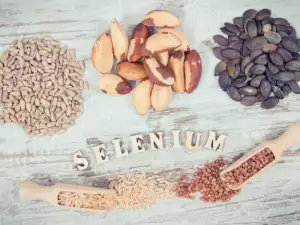Selenium is a trace mineral that needs to be taken in through food every day, but only in very small amounts (50 micrograms or less). Selenium is found in small amounts in the body, which is why we have to get it with food.
Selenium (Se) is an essential mineral for the human body. An interesting fact is that it was considered a toxin until 1957, but according to modern studies, it is not only not dangerous to health, but on the contrary - it brings a number of benefits and is vital for the proper functioning of the body.
Functions of Selenium
Prevention of oxidative stress. Although oxygen is necessary to sustain human life, it is a dangerous substance when found in the body because it can make the molecules too reactive and cause them to damage the cellular structures around them. In chemistry, this unbalanced situation involving oxygen is called oxidative stress.
Selenium helps prevent oxidative stress by working together in a group of other nutrients with a similar function. This group includes vitamin E, vitamin C, glutathione, selenium and vitamin B3.
Supporting the thyroid gland. In addition to iodine, selenium is extremely important for maintaining thyroid function. Selenium is extremely important for the thyroid gland to produce the most active form of its hormone (a version of thyroid hormone called T3) and it also helps regulate the amount of hormone that is already produced.
Cancer prevention. Selenium has been shown to induce DNA repair and synthesis in damaged cells to inhibit the spread of cancer cells, as well as induce their apoptosis (a cycle of self-destruction in which the body removes abnormal cells). Selenium also interacts with many proteins, including glutathione peroxidase, which is particularly important for cancer protection.
Selenium boosts the immune system because it has powerful immunostimulating and antioxidant properties. It is selenium that takes part in the composition of the important enzymes that stop the formation of harmful free radicals that other antioxidants fail to deal with.
Selenium is very important for the synthesis of coenzyme Q10 and the fight against premature aging of the body. It helps the body in fighting allergic reactions, the accumulation of heavy metals in the body and asthma. It increases the levels of white blood cells, which are the main defense against various viruses and colds. In short, selenium plays a key role in good health and a strong immune system. Higher levels of it are thought to help patients with influenza, hepatitis C, HIV and tuberculosis.
The next benefit of selenium is related to heart health. The mineral improves blood circulation and strengthens the heart muscle. According to some data, its deficiency can contribute to the development of heart failure and also accelerate atherosclerosis.
Selenium helps the heart by fighting inflammation in the body, increasing blood flow and reducing oxidative stress.
The mineral plays an important role in the prevention of dementia and memory loss. Increased intake is thought to protect cognitive abilities and improve mental health.

Selenium increases fertility in both men and women. Regular intake increases sperm motility. According to some studies, its deficiency can negatively affect female fertility and fetal development, while regular intake of selenium reduces the risk of miscarriage.
Selenium is extremely important for beauty as well. It supports hair growth and reduces unpleasant dandruff. Very often, for hair loss, doctors recommend taking zinc and selenium, because they support the functioning of hormones and stimulate hair growth.
The mineral is also very valuable for the skin. It reduces the manifestations of acne and cleanses the skin of harmful toxins that pollute it and cause unpleasant pimples.
According to a number of studies selenium is a key factor in increasing life expectancy. It is important to note that as the years progress, the risk of various diseases increases, which selenium can neutralize and thus increase longevity.

Selenium deficiency
Symptoms of prolonged selenium deficiency are seen in two areas of the body, namely the heart and the joints. Regarding the heart, the most characteristic symptom is a specific disease called Keshan disease, which can be prevented with an increased intake of selenium. This disease involves heart arrhythmias and loss of heart tissue. Regarding the joints, there is also a specific disease called Kashin-Beck disease. It is associated with degeneration of the connective tissue.
In severe selenium deficiency accompanied by severe general malnutrition symptoms may include muscle weakness or pain, loss of hair and skin color, and whitening of nail bases.
In some foods, in which a greater percentage of selenium is contained in a water-soluble form, contact with water can lead to a large loss of selenium. For example, when cooking beans, 50% of the original selenium content is lost. In animal foods, the loss of selenium during cooking is minimal.
Dietary deficiency is the most common cause of selenium deficiency. Since the selenium content of plants is highly dependent on the selenium content of the soil, scientists have identified different areas of the world where selenium deficiency is particularly common.
Glucocorticoids are widely used anti-inflammatory drugs based on the prototype of a substance called cortisol. All drugs of this type can reduce the body's supply of selenium.
Selenium is also indirectly responsible for maintaining the body's supply of three other nutrients, namely vitamin C, glutathione and vitamin D. Iron and copper deficiency also increase the risk of selenium deficiency.
Selenium reduces asthma symptoms. The chronic disease affects the airways, which become inflamed and gradually narrow, causing coughing, chest tightness, shortness of breath and wheezing. The mineral helps with this condition as it relieves inflammation.
Selenium overdose
On the other hand, nausea, vomiting, hair loss, skin and nail lesions can be symptoms of selenium toxicity. The levels of selenium needed to trigger these symptoms of toxicity are not usually obtained through food, as selenium-rich foods contain about 30-50 micrograms. Intake of large amounts of selenium is more likely to occur in the case of selenium toxicity of the food itself.
The US National Academy of Sciences sets the tolerable upper limit (UL) for selenium intake of 400 micrograms per day for men and women 19 years of age and older.
Benefits of Selenium
Selenium may play an important role in the prevention and/or treatment of the following diseases: acne, asthma, cervical dysplasia, colorectal cancer, AIDS, male infertility, Kashin Beck disease, Keshan disease, multiple sclerosis, ovarian cysts, Parkinson's disease, psoriasis, rheumatoid arthritis, cataracts, stomach cancer, etc.
Selenium can be found as a dietary supplement in one of two main forms: chelated or unchelated. Of the chelated variety, the most widely available are selenomethionine and selenocysteine. In non-chelated form, the most widely available are sodium selenate and sodium selenite.

Sources of selenium
Brazil nuts are the most highly concentrated source of selenium. Young mushrooms, shiitake mushrooms, cod, shrimp, turtle, tuna, halibut, beef liver and salmon grown in ideal soil conditions are excellent sources of selenium.
Go easy on baked salmon, tuna salad, mushrooms in butter, pan-seared shrimp, or baked beef liver for more selenium.
Very good source of selenium are chicken eggs, lamb, barley, sunflower seeds, mustard seeds and oats.
Keep in mind that prolonged heat treatment destroys the selenium content in the products, so try to subject them to minimal cooking. Whenever possible, prefer fresh food, which is very rich in various minerals and vitamins.















Comments